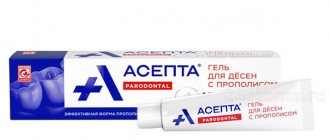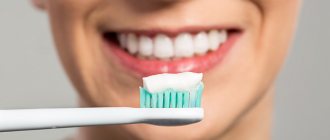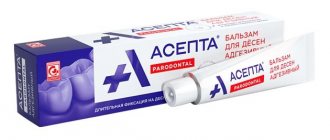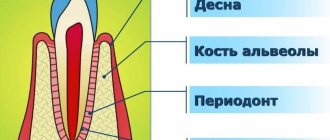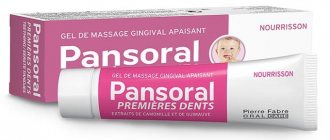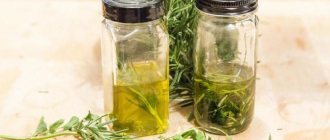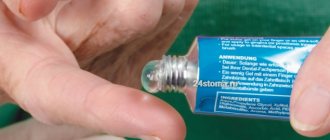From this article you will learn:
- instructions for use, reviews,
- price for Asepta gel in pharmacies,
- differences in composition between Asepta gel and balm.
Asepta gum gel is a dental preparation in gel form used to treat inflammation of the oral mucosa and gums. This drug is the only gel for gums in Russian pharmacies, whose active component is a beekeeping product - propolis. It should be noted that this drug is not registered as a “drug” and therefore it belongs only to the “parapharmaceutical” category.
The drug is produced in Russia. Inside the cardboard package (in addition to the tube with the gel) there is a plastic spatula intended for applying the gel to the gums. You may feel a little weird at first when using this applicator to apply gel to your gums, but it actually does a better job than using your finger. In addition to Asepta gel, there is also ASEPTA in the form of an adhesive balm. This drug no longer contains propolis, but a combination of the antibiotic metronidazole and the antiseptic chlorhexidine (Fig. 2).
ASEPTA in the form of gel and balm for gums: photo
Asepta gum balm, thanks to chlorhexidine and metronidazole, has a much more pronounced antimicrobial effect on pathogenic microflora. This drug will be much more effective in the acute phase of inflammation - compared to its propolis-based version. You can read more about adhesive gum balm here , and in this article we will focus in detail on the gel form.
Indications for use –
- with gingivitis,
- with periodontitis,
- trophic ulcers of the oral mucosa,
- for stomatitis (for epithelization of erosions/aphthae).
Instructions for using Asepta gum gel contain all of the above indications, but not with all of them - you can get a good effect. Each of these indications requires clarification, and therefore we will analyze in detail in our article all the features of using this gel in the treatment of inflammatory processes in the oral cavity.
Asepta Gel: price, composition
For Asepta gum gel, the price for 2021 will be from 190 rubles. The drug has a single release form - in metal tubes of 10 g. The drug is produced by the pharmaceutical company Vertex (Russia), and should certainly be of interest to people who are interested in beekeeping products.
The gel has a viscous consistency and adheres well to the marginal gum around the teeth (it is not washed off with saliva). The gel has a light yellow color and is completely opaque. When applied to the gums, the characteristic pleasant taste of beekeeping products is immediately felt.
Asepta gel for gums: composition
| Content of active substances – → natural propolis extract 10% |
| Auxiliary ingredients – propylene glycol, carbomer, hydrogenated castor oil, triethanolamine, disodium edetate, sodium saccharinate, methylparaben, PEG-40, water. |
→ Asepta gel for gums: instructions for use (download in PDF)
Composition analysis - for gel for gums Asepta instructions for use contain information that the drug has antimicrobial, anti-inflammatory, wound-healing, and analgesic effects. This is true, but this action will not be too pronounced. The anti-inflammatory effect of propolis is very moderate and short-lived, so the drug is suitable only for the periodic prevention of gum inflammation, but not for the treatment of active inflammation.
In addition, upon closer examination of the antimicrobial effect, it turns out that propolis does not act on all types of pathogenic bacteria. For example, it affects gram-positive bacteria, but is absolutely ineffective against gram-negative and anaerobic bacteria (and it is the latter that play an active role in periodontitis). The analgesic effect is minimal and short-lived, and the gel does not have a cooling effect.
The gel can be used as a wound healing agent, but with caution. For example, this should never be done in case of aphthous stomatitis, in which erosions (ulcerations) form on the oral mucosa. The cause of this form of stomatitis in half of the cases may be an allergic reaction, and given that propolis itself is a very allergenic product, it is not advisable to use it in this case.
Conclusions: we recommend using Asepta gel for gums only as a maintenance agent between courses of professional anti-inflammatory therapy. It makes no sense to use this gel to treat gingivitis or periodontitis, because... it does not have sufficient anti-inflammatory or antimicrobial effects. And even its combination with one of the strong antiseptic mouth rinses will not give a good effect.
ASEPTA gel for gums: instructions for use
Asept gel for gums instructions contain information that the gel should be used only after brushing your teeth, applying it in a thin layer to the affected (inflamed) surfaces of the oral mucosa and gums. Before using the gel, it is advisable to additionally dry these surfaces with a dry gauze swab (this will improve the fixation of the gel on the moist mucous membrane). After applying the gel, you should not drink water for at least 30 minutes, and do not eat or rinse your mouth for 2-3 hours after application.
The drug should be used in a course, using it 2-3 times a day for 7-14 days. Preventive courses are carried out 2-3 times a year. Before the course of prevention, it is advisable to visit a periodontist to remove dental plaque, otherwise you will not see much effect from using this remedy (24stoma.ru).
Asepta balm for gums, adhesive
ASEPTA adhesive balm for gums Composition Active substances: Metronidazole - 1.0% Chlorhexidine bigluconate - 0.1% Peppermint essential oil - 0.3% Menthol - 0.008% Excipients: petrolatum oil, sodium carboxymethylcellulose, pectin, petroleum jelly, polyethylene oxide 400, polyethylene glycol ether of lauryl alcohol, methylparaben, propylparaben, sodium saccharinate. Release form: adhesive gum balm 10 g in an aluminum tube. ASEPTA® gum balm is a combined product intended for use in infectious and inflammatory diseases of the oral cavity. The effectiveness of the product is due to the presence in its composition of such antibacterial components as metronidazole and chlorhexidine. Metronidazole is a nitroimidazole derivative, active against anaerobic protozoa and anaerobic bacteria that cause periodontal diseases: Porphyromonas gingivalis, Prevotella intermedia, Prevotella denticola, Fusobacterium fusiformis, Wolinella recta, Treponema spp., Eikenella corrodens, Borrelia vincenti, Bacteroides melaninogenicus, Selenomonas spp. Chlorhexidine is a broad-spectrum antiseptic. Active against vegetative forms of gram-negative and gram-positive microorganisms, yeast, dermatophytes and lipophilic viruses. The effect of the balm is complemented by the bactericidal properties of mint essential oil and the refreshing effect of menthol. Adhesive base The adhesive base of the balm, consisting of pectin and carboxymethylcellulose, when applied to the mucous membrane, swells and fixes within 15-30 minutes. Thus, the active components act locally and for a long time: at the site of inflammation in the oral cavity. Directions for use: 1. Brush your teeth and rinse your mouth. 2. Dry the gums thoroughly with a dry cotton or gauze swab (when applied to a non-dried surface, the duration of action of the balm may be reduced). 3. Without rubbing, apply a thin layer of balm to the gums using your finger or a cotton swab. 4. Moisten the applied balm with water. It is not recommended to eat or drink within 30 minutes after applying the balm. Apply to gums 2 times a day. Duration of use is 7-10 days. To prevent exacerbations of chronic gingivitis and periodontitis, ASEPTA® balm is used 2 times a day for 7-10 days. Preventive courses are carried out 2-3 times a year. Contraindications Individual intolerance to the components of the balm (including chlorhexidine, metronidazole and nitroimidazole derivatives). Pregnancy and lactation There is no experience of using the balm during pregnancy and lactation. Special instructions The use of the balm does not replace hygienic brushing of teeth, therefore, during the course of using the product, teeth brushing should be continued.
ASEPTA gel for gums: reviews
Asepta gel does not have a pronounced antimicrobial and anti-inflammatory effect, and if you expect a noticeable effect from it, you will certainly be dissatisfied with its use.
In our opinion, it is optimal to use the gel only as courses for the prevention of gingivitis/periodontitis. Such courses of maintenance therapy can be carried out 2-3 times a year - between courses of professional anti-inflammatory therapy and removal of dental plaque. Another optimal indication for Asepta gel is periodontal disease, i.e. metabolic-dystrophic gum disease that occurs in elderly patients due to deterioration of blood microcirculation in the bone tissue of the jaws. But periodontal disease should not be confused with gingivitis and periodontitis. Gingivitis and periodontitis are inflammatory diseases of the gums, and with them there is always swelling and bleeding of the gums.
And with periodontal disease, inflammation in the gums is always absent, and symptoms are manifested only by a gradual progressive decrease in the level of bone tissue around the teeth, leading to exposure of the surface of the roots. Moreover, the use of Asept gel for periodontal disease will not be accompanied by visible improvements, and its use will only slightly slow down the process of bone tissue degeneration.
Important: reviews on ASEPTA gum gel for use (for erosions and ulcers due to stomatitis) boil down to the fact that the drug is ineffective for these purposes. It is best to use other forms of drugs to treat painful erosions, for example, Cholisal gel, which not only relieves pain, but also reduces inflammation and speeds up the healing of ulcerations.
Contraindications and side effects -
When applied to the mucous membrane, the components of the drug do not have any systemic effect. Occasionally, only allergic reactions may occur. It is precisely because of the latter that Asept gel is not recommended for use in aphthous stomatitis, because Often it is an allergic reaction that causes aphthae (ulcers) to appear on the mucous membrane. And applying propolis gel to ulcers can only worsen their healing.
An absolute contraindication is an allergy to bee products, or an allergy to one of the components of the gel. The use of the gel during pregnancy and lactation is not recommended, because the manufacturer notes that clinical studies on this issue have not been conducted.
Cholisal gel stomat 15 g pack card x1
Release form, composition and packaging Dental gel in the form of a colorless, transparent, homogeneous mass with the smell of anise oil. 1 g choline salicylate 87.1 mg cetalkonium chloride 100 mcg
Excipients: hyaetellose - 20 mg, methyl parahydroxybenzoate - 1.5 mg, propyl parahydroxybenzoate - 0.8 mg, glycerol - 50 mg, anise seed oil - 1.61 mg, ethanol 96% - 390 mg, water - up to 1000 mg.
Clinical and pharmacological group: Drug with antimicrobial, anti-inflammatory and analgesic effects for local use in dentistry Pharmaco-therapeutic group: NSAIDs Pharmacological action Combined drug for local use in dentistry with antimicrobial, anti-inflammatory and analgesic effects.
When applied topically, choline salicylate is quickly absorbed by the oral mucosa, providing local analgesic, anti-inflammatory and antipyretic effects. It inhibits the activity of COX, the functions of macrophages and neutrophils, the production of interleukin-1 and inhibits the synthesis of prostaglandins. It also has antimicrobial and antifungal effects in acidic and alkaline environments.
Cetalkonium chloride is an antiseptic that acts on bacteria, fungi and viruses.
The gel ethanol-containing adhesive base ensures rapid development of the effect and retains the active substances on the mucous membrane for a long time.
The analgesic effect occurs within 2-3 minutes, while its duration is 2-8 hours.
Pharmacokinetics When applied to mucous membranes, it is well absorbed. Indications For local use on the mucous membranes of the oral cavity as an analgesic and anti-inflammatory agent in the treatment of periodontal diseases, damage to the mucous membrane, diseases occurring with an inflammatory reaction and pain:
- stomatitis of various etiologies,
- gingivitis,
- periodontitis,
- damage to the oral mucosa when wearing dentures,
- trauma to the oral mucosa,
- pain during teething in children,
- cheilitis,
- candidiasis of the oral mucosa,
- minor surgical interventions in the oral cavity,
- lichen planus when localized on the oral mucosa,
— damage to the oral mucosa in Stevens-Johnson syndrome (as part of complex therapy).
ICD-10 codes ICD-10 code Indication B37.0 Candidal stomatitis K00.7 Teething syndrome K05 Gingivitis and periodontal diseases K12 Stomatitis and related lesions L43 Lichen planus L51.1 Bullous erythema multiforme (Stevens-Johnson syndrome) Z51.4 Preparatory procedures for subsequent treatment or examination, not elsewhere classified
Dosage regimen Cholisal® is used topically 2-3 times a day before meals (for pain relief) or after meals and before bedtime. A strip of gel 1 cm long for adults and 0.5 cm for children is squeezed onto a clean finger and rubbed with light massaging movements into the affected area of the oral mucosa.
For periodontal diseases, the gel should be placed in the gum pockets or applied in the form of compresses, or gently rubbed into the gums 1-2 times a day.
Side effects Local reactions: a short-term burning sensation at the site of application of the drug, which goes away on its own.
Other: allergic reactions.
Contraindications for use: hypersensitivity to salicylates and other components of the drug.
The drug should be used with caution during pregnancy, during breastfeeding and in children under 1 year of age.
Use during pregnancy and breastfeeding Cholisal® should be used with caution during pregnancy and breastfeeding. Use in children The drug should be used with caution in children under 1 year of age. Special instructions When the first signs of a side effect appear, the patient should immediately contact their doctor.
The drug should be used for topical use only.
The drug does not contain sugar.
Impact on the ability to drive vehicles and operate machinery
The drug does not limit psychophysical activity, the ability to drive vehicles or maintain moving mechanisms.
Overdose No cases of overdose have been identified. Drug interactions When using Cholisal in doses significantly higher than recommended, it is possible to enhance the effect of other simultaneously used anti-inflammatory, antipyretic and analgesic drugs.
Conditions for dispensing from pharmacies The drug is approved for use as an over-the-counter product.
Conditions and periods of storage The drug should be stored out of the reach of children at a temperature not exceeding 25°C, and do not freeze. Shelf life: 3 years.
ASEPTA gum balm –
The drug Asepta gum balm (instructions) contains antimicrobial components - the antibiotic metronidazole 1.0% and the antiseptic chlorhexidine 0.1%, which act on pathogenic bacteria that cause inflammation of the gums. In addition, ASEPTA adhesive balm for gums contains pectin and cellulose, which, when released into the moist environment of the oral cavity, acquire the consistency of a gel (thanks to this, the drug is well fixed on the mucous membrane).
Asepta gum balm - reviews are no different from reviews of a drug such as MetrogilDenta. Both drugs are of average effectiveness and contain only antimicrobial components (do not contain anti-inflammatory components). It should be noted that Asepta balm contains 2 times more concentration of chlorhexidine - in comparison with Metrogil denta, but they have the same concentration of metronidazole. We hope that our article: Balm and gel ASEPTA price and reviews was useful to you!
Sources:
1. Add. professional
, 2. Based on personal experience as a periodontist, 3. https://asepta.ru/, 4. “Therapeutic dentistry. Textbook" (Borovsky E.V.).
